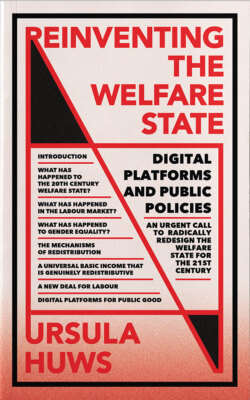Читать книгу Reinventing the Welfare State - Ursula Huws - Страница 15
На сайте Литреса книга снята с продажи.
A REVERSAL IN THE DIRECTION OF REDISTRIBUTION
ОглавлениеIt is widely believed that the state institutions inherited from this period still play the same role. After all, don’t we still have healthcare that is ‘free at the point of delivery’, child benefit, housing benefit and a form of guaranteed income for the unemployed (the latest version of which is Universal Credit)? And don’t the statistics show that the amount of money spent on social security, health and pensions is higher than ever before?
Such a view fails to grasp the immensity of the changes that have taken place in the intervening period. The twenty-first-century welfare state, while still inhabiting the institutional carcass of that of the twentieth century, now has a fundamentally different character. Far from redistributing from the rich to the poor, or from capital to labour, it now acts a vehicle for its exact opposite: a redistribution from the poor to the rich, from labour to capital.
How can this be? To answer this question we need to look first at who is putting money into the system – the taxpayers – and then at who the beneficiaries are. Those who get their information from the tabloid press or from television shows such as Saints and Scroungers or Benefits Street might find it difficult to believe that the welfare system is not simply channelling money from ‘hard-working taxpayers’ to ‘scroungers’. But in fact the pattern of contribution to government income has changed substantially. Less and less of this income is coming from corporations and the rich and more and more from VAT (Value Added Tax) and other indirect taxes. This shift has accelerated since the recession of 2008. A 2016 report from the Institute for Fiscal Studies found that ‘there have been substantial reductions in revenues from personal income, capital and corporation taxes as a proportion of national income. This has been partially offset … by more revenue from indirect taxes, driven almost entirely by the increase in the VAT rate to 20 per cent from April 2012.’2 And, as Richard Murphy has demonstrated, the poorest households in the UK have both the highest overall tax burden and the highest VAT burden. Meanwhile, many large global corporations – including those that benefit from employing low-paid workers – pay no tax whatsoever in the UK.
So, the poor are contributing disproportionately to the pot of money that pays for public services and welfare benefits. But surely they are also the main beneficiaries? Wrong again. Neoliberal policies have in fact turned the welfare state inside out to such an extent that private companies and rich individuals benefit from it disproportionately. Where does the spending on housing benefit go? Much of it to private landlords. Where does the spending on health and education go? Much of it to development companies (under PFI3 deals), pharmaceutical companies, privately run academy schools and the multinational companies such as SERCO and G4S that provide the public sector with outsourced services. A report from the Institute of Government estimated that in 2017–18 the UK government spent £284 billion (rising to £300 billion if academies are included) on buying goods and services from external suppliers, amounting to a third of all public sector expenditure.4 Many of the companies that benefit from these government contracts pay little or no tax. Virgin Care Services, for example – which made £8 million profit from NHS contracts with a turnover of £200 million in 2017 – paid no corporation tax on these profits for the second year running.5
And what about tax credits, the antecedent of the Universal Credit currently being rolled out? These were introduced by the New Labour government in the 1990s with the aim of reducing poverty while avoiding disincentives to work, taking the form of a top-up to low wages to bring household incomes up to an agreed threshold for certain categories of worker, such as lone parents. It was estimated that by 2015 expenditure on these credits, which had originally cost £1.1 billion annually, had reached £30 billion per annum.6 Since tax credits are paid as a top-up to low earnings they must, so the narrative goes, end up in the pockets of the poorest workers. But why are these workers’ earnings so low? It is, surely, because their employers are paying them so little that they cannot survive without the top up. Which means that the subsidy is going, not to the underpaid workers, but to the cheapskate employers who refuse to pay them a subsistence income. In other words it is a direct subsidy from the state to the employers that pay low wages. To add insult to injury, many of these employers pay little or no tax on their profits. Amazon, for example, which in 2019 employed 27,500 people in the UK, paid only £220 million in direct taxes in the UK, despite its total revenues from doing business in the country amounting to £10 billion.7 The previous year it was reported that Starbucks, another large employer in the UK, paid effectively only 2.8 per cent UK tax.8
